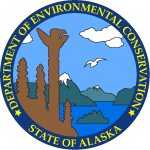| Action Date |
Action |
Description |
DEC Staff |
| 2/11/1991 |
Update or Other Action |
A 5,000 gallon diesel fuel UST was removed in 1990 and an unknown amount of soil was excavated and stockpiled. Soil samples collected from the excavation provide conflicting data on BTEX. Residual contamination may exceed cleanup levels. No details provided in report. |
Louis Howard |
| 1/1/1992 |
Site Added to Database |
|
Louis Howard |
| 9/21/1993 |
Update or Other Action |
A.G. letter (Breck Tostevin) to Tamela J. Tobia, OS Judge Advocate for the Army. Letter states that a separate petroleum site compliance agreement should be separate from the CERCLA federal facility agreement. The petroleum site restoration agreement would function as a "two-party agreement" under the FFA. It would track the basic provisions of the UST Agreement but be tailored to the State's contaminated site regulations and would interface with the FFA. All petroleum sites addressed under the Two Party agreement would be reviewed in the final operable unit of the FFA and actions taken would be memorialized in a Record of Decision (ROD) under the FFA. |
Louis Howard |
| 2/9/1994 |
Notice of Violation |
Compliance advisory signed by Janice Adair (Regional Administrator) sent to Army in reference to Fort Richardson UST compliance agreement for Tank 26 at Building 786. This advisory is being sent to notify the Army of its failure to comply, in a timely manner, with the Underground Storage Tank (UST) Compliance Agreement ("agreement") Upgrading of USTs (Para. 25) and Free Product Recovery and Soil Remediation (Para. 40). In an effort to keep the working relationship that the Army and the department have established, the department would like to move forward with the agreement's intent and goals, which is to come into compliance with the UST regulations. A review of our records did not produce any information indicating the Army has complied with closure or upgrade requirements, outlined in Attachment D, for the following tanks and expected dates: UST 26, Bldg 786 Driver's Training 9/30/93, USTs 40 & 41, Bldg 979 POL Gas Station, 9/30/93, UST 57, Bldg 39600, Site Summit, 9/30/93, UST 92, Bldg 732 Resrv. Motor Pool 9/30/93.
Attachment I Petroleum Contaminated Soil Stockpiles- The Army has not submitted a final corrective action report for each site as required by 18 AAC 78.340. Soil Pile (SP) and expected date of completion was 10/30/1993: SP 1 Bldg 8102 Arctic Valley, SP 3B Bldg. 796 Vehicle Maintenance, SP 4 Bldg. 908S 1117th Sig. Batt., SP 5 Bldg. 908N 1117th Sig. Batt., SP 6 Bldg 702 Gas Pump Bldg., SP 7 Flying Club, SP 8 Bldg 733, SP 9 Bldg 798 Motor Pool, SP 10 Bldg 782 Gas Station, SP 11 Fuel Depot, SP 12 Bldg 47622 Bryant Airfield, SP 13, and SP 15 Bldg 55804 Ammo Area A. |
Janice Adair |
| 2/23/1994 |
Update or Other Action |
Letter to Army RE: December 8, 1993 Work Plan UST Release Investigation "A" Seven Fuel Tank Locations Contract No. DACA 85-93-D-008, Dames and Moore. Staff received the document on January 28, 1994. It contains the plans for release investigation work at: Bldg. 712, 762, 782, 8102, 27004, 47622, and 47633. ADEC, DPW and the contractor have previously met at our office and discussed the draft work plan proposals for this investigation. The document appears to have addressed ADEC's concerns. Being that the field work has already been conducted, the department will not provide review and approval of the work plan, but will review the draft release investigation report which is to be submitted within 100 days of completion of field work. |
Louis Howard |
| 5/17/1994 |
Document, Report, or Work plan Review - other |
Staff reviewed and commented on the April 1994 Draft UST Release Investigations "A", Seven Fuel Tank Locations Building 782, Fort Richardson, Alaska
The Alaska Department of Environmental Conservation-Defense Facilities Oversight group (ADEC)
has received on, April 25, 1994, a copy of the above referenced report for building 782. Below are our comments regarding the document.
2.4.1 Nearby drinking water Sources pages 4 and 5
The text states there are three wells on Fort Richardson with one of the wells approximately 0.3 miles southeast of building 782. Please elaborate further on whether this well is a domestic well, institutional well or the unused well referenced in the text. The definition of what constitutes an institutional well needs to be stated here and the type of unused well being referenced, i.e. an unused drinking water or an unused fire suppression supply well, etc.
2.4.2 Regional Hydrology page 5
The text states the depths of three wells are 60 to 61. 7 feet below ground surface (bgs) and reported depths to water range from 35 to 58.5 feet bgs. Please elaborate as to which wells are being referred to in this section and list the specific depths to water being reported for each well.
4.4.1 Distribution of Concentration of Hydrocarbon Compounds page 14
The text states the hydrocarbon contamination migrated to a depth of 20 feet and spread along a
feature at that depth, however the feature is not supported by data found in the bore logs in
Appendix C. Please elaborate on the probable cause of the spreading hydrocarbon contamination at the 20 foot depth.
4.4.3 Cleanup Levels page 16
The text states the ranking was calculated assuming a depth to groundwater at the site is 100 feet or more. This is in contradiction with the preceding statement in section 2.4.2 where the depths to groundwater were from 38 to 58.5 feet bgs. Using 20 feet as maximum depth of contamination at the site and 58.5 feet for a depth to groundwater would increase the overall matrix score by 3 points from 32 to 35 (Level B).
5.3 Recommended Action Page 27
The text states that the Army could have the site reclassified to Level C by closing out the well near the athletic field and possibly the well located in the warehouse area. For ADEC to consider a change of the matrix score from Level B to Level C the Army must close out the three wells located within one mile of the site and invoke institutional controls on groundwater, i.e. no new drinking water wells developed in the area.
After implementing these recommended actions, then ADEC will consider the site closed. Closing out of the site does not limit nor preclude ADEC from requesting future remediation or site investigation at a later date. If new information indicates that there is previously undiscovered contamination or exposures that would cause an increased risk to human health or the environment, then future investigation and/or remedial actions may be required by ADEC.
Figure 1
The site vicinity map indicates UST sites and five nearby water wells. Please indicate on which wells are drinking water wells, institutional wells, or unused wells. |
Louis Howard |
| 11/16/1994 |
Site Closure Approved |
Staff reviewed and commented on the FINAL August 12, 1994 UST Release Investigations "A", Seven Fuel Tank Locations Building 782, Fort Richardson, Alaska
The Alaska Department of Environmental Conservation-Defense Facilities Oversight group (ADEC)
has received on, September 13, 1994, a copy of the above referenced report. Based on the current
information presented in the document ADEC concurs that level C cleanup criteria is appropriate for the site and has not been exceeded. Therefore, ADEC will consider the site closed out requiring no further remediation or investigation at this time.
Matrix closed. Soil contamination was below level "C" criteria (1,000 mg/kg DRO, 500 mg/kg GRO, 50 mg/kg BTEX). Area around USTs 23 and 24 has been asphalted over thus eliminating potential pathways for inadvertent exposure through inhalation, ingestion or dermal contact. Further the asphalt at the site is expected to impede potential leaching of water through any residual contaminated soils. |
Louis Howard |
| 6/16/1995 |
Site Ranked Using the AHRM |
Initial ranking. Action code added because it wasn't when the site was originally ranked. |
Louis Howard |
| 8/29/2007 |
GIS Position Updated |
61.2592 N latitude -149.6895 W longitude |
Louis Howard |




